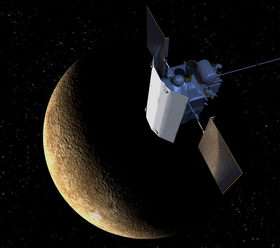This artist's impression shows NASA´s Mercury-bound MESSENGER from the sunshade side. The sunshade shields the spacecraft's instruments from heat and solar radiation. Image Credit: Johns Hopkins University Applied Physics Laboratory
(Phys.org) -- The MESSENGER spacecraft launched eight years ago today — on August 3, 2004 — embarking on a six-and-a-half year journey to become the first spacecraft to orbit Mercury. The spacecraft's 4.9-billion mile (7.9-billion kilometer) cruise to history included 15 trips around the Sun, a flyby of Earth, two flybys of Venus, and three flybys of Mercury.
The mission began capturing ground-breaking science and images from outer space almost immediately. During its gravity assist swing-by of Earth, on August 2, 2005, MESSENGER's cameras captured several hundred images of our planet. These images were sequenced into a movie documenting the view from MESSENGER as it departed Earth toward the inner Solar System.
On October 24, 2006, the spacecraft soared above the cloud deck of Venus for the first time, then returned less than a year later on June 5, 2007, marking the first time in flight that all seven instruments were turned on and operating collectively in science-observing mode. MESSENGER turned its wide-angle camera back to the planet and acquired a departure sequence that provided a spectacular good-bye to the cloud-shrouded planet while also acquiring valuable calibration data for the camera team.
MESSENGER made history on January 14, 2008, when it flew over a portion of Mercury that had never before been seen at close range. In this first of three flybys of the planet, the probe's cameras took 1,213 images and other sophisticated instruments made the first spacecraft measurements of the planet and its environment since Mariner 10's third and final flyby on March 16, 1975.
The mission's penultimate accomplishment — entering orbit about Mercury — was celebrated on March 17, 2011, by a crowd of hundreds gathered at the Johns Hopkins University Applied Physics Laboratory in Laurel, Maryland. The event was covered live, and the webcast is still available online at messenger.jhuapl.edu/mer_orbit.html.
On March 17, 2012, MESSENGER successfully completed a year-long campaign to perform the first global reconnaissance of the geochemistry, geophysics, geologic history, atmosphere, magnetosphere, and plasma environment of the solar system's innermost planet. The following day, March 18, 2012, marked the official start of an extended mission phase designed to build upon those discoveries. This animation shows a sunward view of MESSENGER above Mercury's north polar region during the two orbit-correction maneuvers on April 16 and April 20, 2012, which shortened the orbit period from 12 to 8 hours, allowing MESSENGER an even closer look at the planet.
Less than five months into the extended mission, the team has already made substantial progress on its new objectives. Next week, the team will gather for its 27th Science Team Meeting in Salem, Massachusetts, to discuss the new findings and firm up plans for a second extended mission.
"Our small spacecraft has been a hardy traveler," says MESSENGER Principal Investigator Sean Solomon, of the Lamont-Doherty Earth Observatory at Columbia University. "Across billions of miles, during more than 1,000 orbits about the planet with the greatest extremes in surface temperature, and in the face of streams of energetic particles from an increasingly active Sun, MESSENGER has continued to surpass expectations. Mercury, too, has continued to surprise the scientific community, and the MESSENGER team looks forward to learning more about one of the nearest yet least studied worlds."
Provided by NASA





















